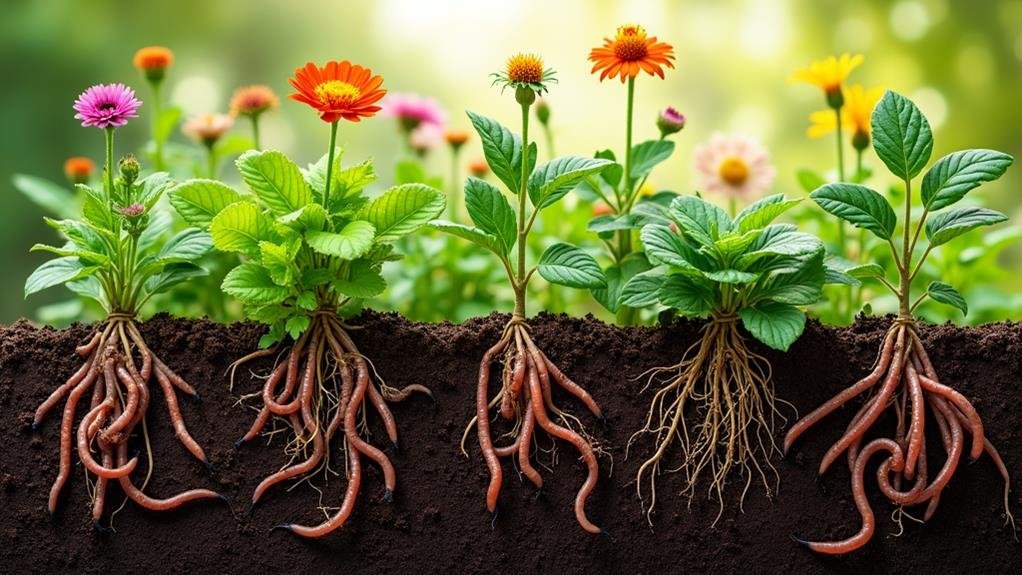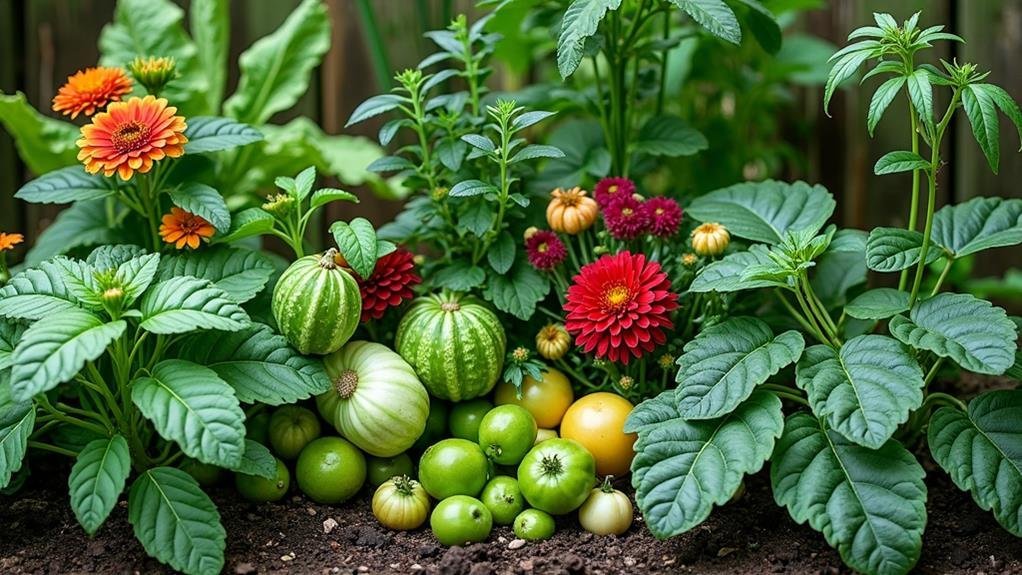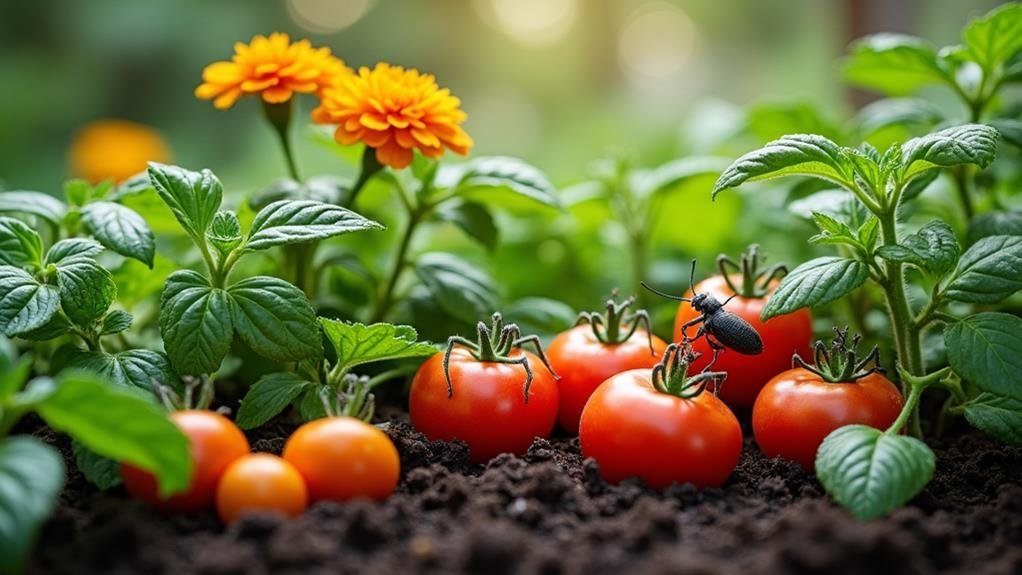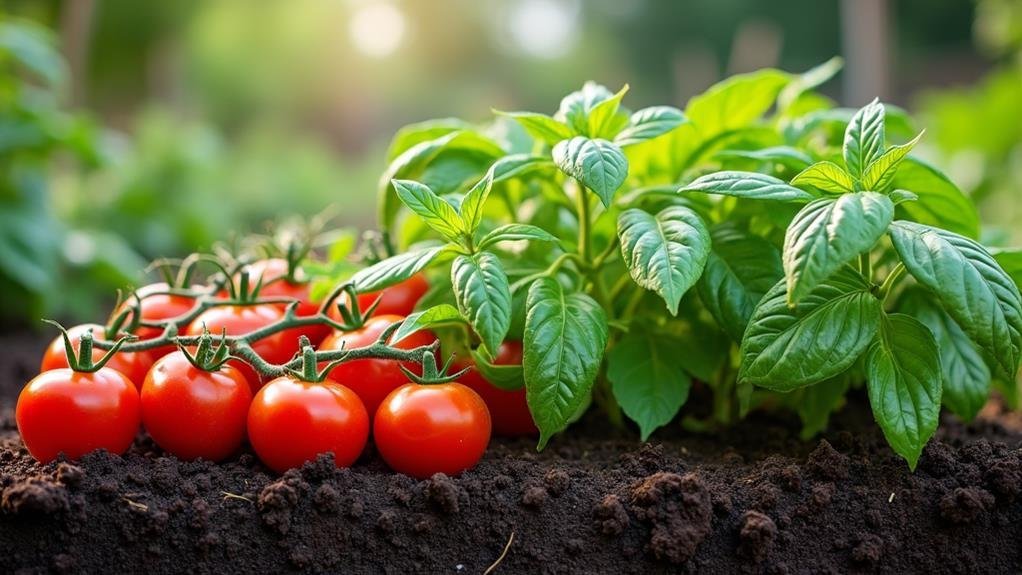When you think about maximizing your garden's potential, companion planting can be a game changer. By pairing plants strategically, you can boost growth, improve soil health, and naturally deter pests. This method not only optimizes space but also fosters a vibrant ecosystem that supports beneficial insects and pollinators. You might be surprised at how certain combinations can even raise the flavors of your harvest. Curious about which plant partners can transform your garden into a thriving sanctuary?
Enhanced Plant Growth

Companion planting is a powerful technique that can greatly improve plant growth in your garden. By strategically placing plants together, you create a harmonious environment that boosts each plant's ability to thrive. For instance, when you plant tomatoes alongside basil, they not only enrich each other's flavors but also promote better growth.
Certain plants can provide essential nutrients to their neighbors. For example, legumes like beans fix nitrogen in the soil, enriching it for nearby plants. This natural fertilization helps your garden flourish without the need for chemical fertilizers.
Additionally, some plants can create microclimates, offering shade or wind protection, which is particularly beneficial for more delicate species.
You might also notice that certain combinations can lead to more robust root systems. When plants grow together, they often establish a deeper connection with the soil, allowing them to access more water and nutrients.
Pest Control Benefits
Effective pest control is another significant advantage of companion planting. By strategically pairing plants, you can create a natural barrier against pests that threaten your garden. Certain plants, like marigolds, emit scents that repel harmful insects. When you plant them alongside vegetables, you'll notice fewer pests invading your prized crops.
Additionally, some plants attract beneficial insects, such as ladybugs and lacewings, which feast on the pests you don't want. For example, planting dill near cabbage can draw in these helpful insects, keeping your garden healthy and thriving.
You can also confuse pests with companion planting. For instance, mixing up your crops makes it harder for pests to locate their preferred targets. This diversity is a simple yet effective way to reduce infestations without resorting to chemical pesticides.
Improved Soil Health

How can companion planting improve soil health? When you pair plants wisely, you create a thriving ecosystem that nourishes the soil.
For example, deep-rooted plants, like carrots, can help break up compacted soil, allowing air and water to penetrate more easily. This aeration encourages beneficial microbes to flourish, which are essential for nutrient cycling.
Additionally, certain plants, such as legumes, have the ability to fix nitrogen in the soil. By planting them alongside crops that require nitrogen, you naturally enrich your soil, reducing the need for synthetic fertilizers. This not only boosts plant growth but also fosters a healthier environment.
Moreover, companion plants can help prevent soil erosion. Their diverse root systems stabilize the soil, minimizing nutrient loss during heavy rains.
You might also find that some plants, like marigolds, deter pests while attracting beneficial insects, further promoting a balanced ecosystem.
Incorporating companion planting into your garden design can lead to improved soil structure and fertility. By nurturing the soil health, you're setting the stage for a more productive and resilient garden, and who wouldn't want that?
Increased Biodiversity
In the garden, pairing different plant species can greatly improve biodiversity. When you mix various plants, you create a more balanced ecosystem. This diversity attracts a range of beneficial insects, like pollinators and predatory bugs, which help control pests naturally. For instance, planting marigolds near tomatoes can draw in ladybugs that feast on aphids, keeping your plants healthy.
Moreover, diverse plant life supports a wider range of soil microbes, which boosts nutrient cycling. These microorganisms play an essential role in breaking down organic matter and making nutrients available to your plants.
With increased biodiversity, you're not just focusing on one type of plant; you're fostering a community that can better withstand diseases and pests.
Space Optimization

When you adopt companion planting, you can make the most of your garden space. This method encourages you to grow compatible plants together, allowing them to share resources and thrive. By strategically placing plants that benefit each other, you can maximize your garden's potential.
For instance, taller plants can provide shade for those that prefer a cooler environment, while low-growing varieties can cover the soil, helping to retain moisture.
You'll also find that certain plants, when grown together, can deter pests that might otherwise invade your garden. Imagine having a vibrant patch of tomatoes flourishing alongside basil and marigolds. Not only does this combination create a stunning visual display, but it also helps each plant reach its full potential, reducing the need for excessive spacing.
Additionally, companion planting can lead to more efficient use of nutrients in the soil. By alternating deep and shallow-rooted plants, you can guarantee that the soil is fully utilized, preventing nutrient depletion.
Embracing this approach transforms your garden into a dynamic ecosystem, where every inch counts, and you'll soon see the benefits in both yield and health of your plants.
Natural Weed Suppression
Companion planting not only optimizes space but also helps with natural weed suppression. By strategically placing plants together, you can create a dense canopy that blocks sunlight, making it difficult for weeds to germinate and thrive. For instance, taller plants, like sunflowers, can provide shade for shorter companions, reducing the chances of weed growth around them.
Additionally, certain companion plants can outcompete weeds for nutrients and water. For example, legumes, such as peas or beans, fix nitrogen in the soil, enriching it while simultaneously taking up resources that weeds would otherwise exploit. This natural competition makes it harder for unwanted plants to establish themselves.
Moreover, some plants release allelopathic chemicals that inhibit weed growth. A well-known example is the black walnut, which can suppress the growth of many weeds nearby.
By incorporating these strategies into your planting design, you not only minimize weed pressures but also cultivate a healthier garden ecosystem.
Incorporating companion planting for natural weed suppression is a simple yet effective way to maintain your garden. With a little planning, you can enjoy a vibrant, thriving space with considerably less weeding.
Pollinator Attraction

How can you create a thriving garden that attracts pollinators? One of the best ways is through companion planting. By choosing plants that naturally attract bees, butterflies, and other pollinators, you can improve your garden's ecosystem. Flowers like marigolds, sunflowers, and zinnias not only beautify your space but also draw in these vital creatures.
When you pair flowering plants with your fruits and vegetables, you create a win-win situation. For example, planting borage near strawberries can attract pollinators that boost your berry yield.
Additionally, consider incorporating herbs like basil or lavender, which are known for their pollinator-friendly qualities.
It's essential to maintain a variety of colors and shapes in your garden. Different pollinators are attracted to different types of flowers, so diversity is key.
Avoid using pesticides, as they can harm the very insects you're trying to attract. Instead, opt for natural pest control methods.
Flavor Enhancement
While you may not realize it, the right companion plants can greatly improve the flavor of your fruits and vegetables. By strategically pairing certain plants, you can enrich their taste and aroma.
For example, when you grow basil alongside tomatoes, the basil not only repels pests but also raises the tomato's flavor, creating a delicious blend that's hard to resist.
Another great combination is onions and carrots. Onions can deter carrot flies, while the carrots benefit from the onion's presence, ultimately resulting in sweeter, more flavorful roots.
Think of companion planting as a culinary team-up in your garden, where each plant plays a role in boosting flavor profiles.
Herbs are particularly beneficial, as they often release essential oils that can enrich the taste of nearby crops.
Consider planting dill with cabbage or parsley with asparagus; both pairings can produce more flavorful harvests.
Disease Resistance

Pairing plants not only improves flavor but can also bolster disease resistance in your garden. When you strategically combine certain plants, you create a more resilient ecosystem.
For instance, some plants can repel pests that typically attack their neighbors. Marigolds, for example, are known for deterring nematodes and other unwanted insects, protecting nearby vegetables.
Additionally, diverse plantings can reduce the spread of diseases. When you plant a variety of species, you minimize the risk of any single disease wiping out your entire crop. For example, planting garlic among your tomatoes can help prevent fungal infections, thanks to garlic's natural antifungal properties.
Moreover, companion planting encourages beneficial insects, which act as natural predators to harmful pests. Ladybugs and lacewings, attracted by certain plants, can keep aphid populations in check, further safeguarding your garden.
Conclusion
Incorporating companion planting into your garden can truly transform your gardening experience. By pairing plants wisely, you can boost growth, control pests naturally, and enrich soil health. Additionally, you'll attract beneficial pollinators and elevate the flavors of your crops. This sustainable practice not only optimizes space but also supports a diverse ecosystem. So, why not give it a try? Your garden will thrive, and you'll enjoy the fruits of your labor even more! When getting started with companion planting, it’s helpful to research and learn about specific plants that work well together. Some common companion planting tips include avoiding planting vegetables from the same family next to each other, such as tomatoes and peppers, to prevent disease and nutrient competition. Additionally, consider the height and growth habits of your plants to ensure they won’t shade or crowd each other out. With a little planning and experimentation, you’ll soon discover the many benefits of companion planting in your garden.




